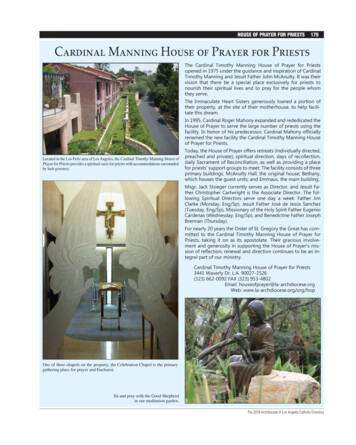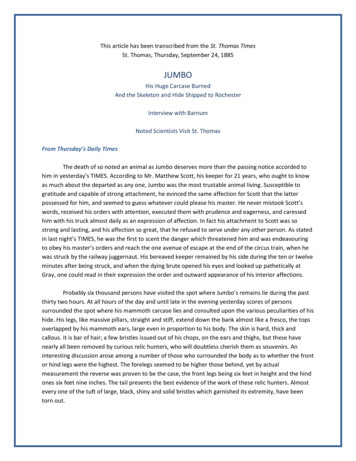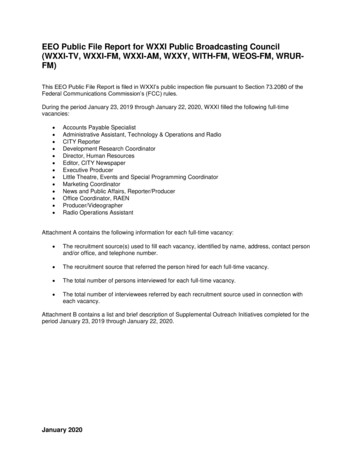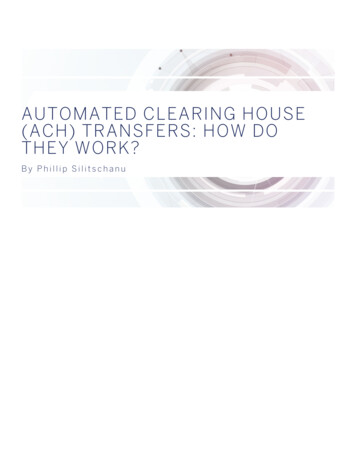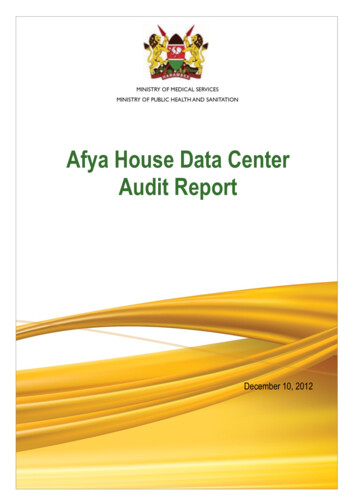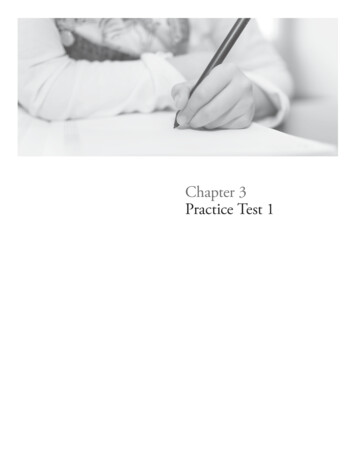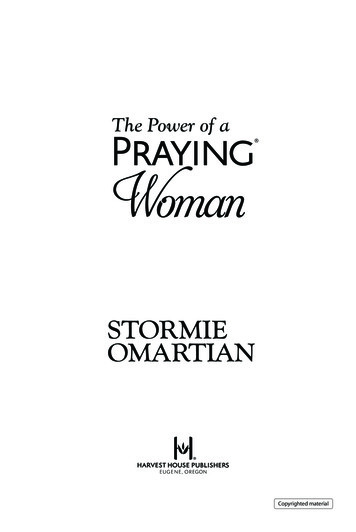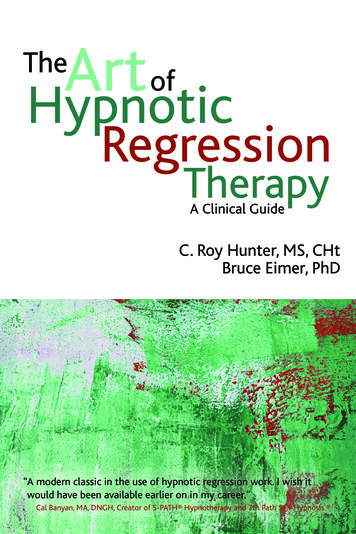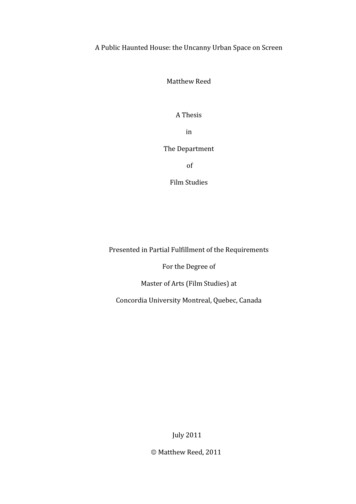
Transcription
A Public Haunted House: the Uncanny Urban Space on ScreenMatthew ReedA ThesisinThe DepartmentofFilm StudiesPresented in Partial Fulfillment of the RequirementsFor the Degree ofMaster of Arts (Film Studies) atConcordia University Montreal, Quebec, CanadaJuly 2011Matthew Reed, 2011
CONCORDIA UNIVERSITYSchool of Graduate StudiesThis is to certify that the thesis preparedBy:Matthew ReedEntitled:A Public Haunted House: the Uncanny Urban Space on ScreenAnd submitted in partial fulfillment of the requirement for the degree ofMaster of Arts (Film Studies)Complies with the regulations of the University and meets the accepted standardswith respects to originality and quality.Read and approved by the following jury members:Michael CowanExternal ExaminerHaidee WassonExaminerCatherine RussellSupervisorApproved by12 September 2011Luca CaminatiDateGraduate Programme Director12 September 2011Catherine WildDateDean of Faculty
ABSTRACTA Public Haunted House: the Uncanny Urban Space on ScreenMatthew ReedThis thesis investigates how specific urban built forms have been used tounsettle cinema audiences at certain points in cinematic and architecturalhistory. Drawing upon Freud’s theory of the uncanny in combination withextensive architectural criticism and discourse on cinema and its intersectionwith the city, I argue that uncanny architecture provides a fundamental criticalframework for representing, expressing and dramatizing fear towards themetropolis. Divided into three chapters I analyze three different architecturalepochs revolving around a historical narrative of the emergence, decay andabsence of architectural Modernism. Beginning in Weimar Berlin I examineWalter Ruttmann’s exploration of first wave Modernity in Berlin, Symphony of aGreat City (1927) and his exploitation of the primal, mystical uncanniness hiddenwithin a city of proposed rationality, functionalism and strict geometry. I thenturn to the architecture of British brutalism and explore a shining modernitydecayed into neo-gothic ruins, in Andrea Arnold’s Red Road (2006) in which aBritish audience is haunted by the ghost of an earlier social idealism. I thenconclude by moving to contemporary Tokyo in Kiyoshi Kurosawa’s Pulse (2001)and confront the uncanniness endemic in a city invested so heavily in nonhuman technology and “non-architecture”. Throughout I argue that themetropolis will always find a way to haunt itself. Ideas of transience, death andspatial disorientation will remain fixed foundations for any developed city andthat the urban uncanny is a malleable, shifting condition, consistently capitalizedon by the cinema.iii
iv
TABLE OF CONTENTSList of illustrationsIntroductionThe Uncanny in Film and ArchitectureThe Uncanny and the Death Instinctvi/ii148Chapter 1A Symphony for the MachinesNew Fantasies202732Chapter 2What the Future Looked LikeTwo Places at OnceCinema and the New RuinsRed Road4852626973ConclusionThe End of ModernismThe Vanished CityMalignant Empty SpacesA Positive Exploration of Voids849197102107Bibliography112v
LIST OF ILLUSTRATIONS29 – “An Uncanny Urban Stage”: an empty street view and shop-front manikinsin Act One in Berlin, Symphony of a Great City31 – “Industrial Monsters and Monoliths”: industrial machinery in Act one inBerlin34 – “An Interpenetration of Hovering Planes”: an apartment block in Act 2 inBerlin36 – The Bauhaus School at Dessau, designed by Walter Gropius 192638 – “Urban dread”: a woman ponders suicide in Act 4 in Berlin44 – “The Mobile Threshold”: doors in Act One in Berlin46 – “Porous Interiors”: station thresholds from throughout Berlin48 – Park Hill Flats, Sheffield, early eighties49 – Still from Marger - My Thing (music video)56 – Gateshead multistory car park in 2008, Trellick tower 200357- Heygate Estate 200859 – Robin Hood Gardens 201062 – Thamesmead Upon Opening, in 1969(aprox) and the Heygate EstateAbandoned in 201067 – “The Two Thamesmeads”: Still from A Clockwork Orange and a picture oftwo Residents in the early seventies with both images displaying the samelakeside walkway.74 – The Tricorn Southampton and Gateshead Multi Story Car Park beingdemolished in 2004 and 2010 respectively.75 – Red Road being built in 1968 Red Road being demolished in 2008.76 – Jackie crosses the boundary into Red Road (still from Red Road)77 – “Recording Walls”: Red Road’s decaying concrete (still from Red Road)78- “Neo-Gothic”: A Brutalist Castille (still from Red Road)79 – Jackie watches spectral figures on the CCTV screen (still from Red Road)vi
94 – Frank Gehry’s Guggenheim Museum, Bilbao, Spain 199797 – Richard Roger’s Terminal Five building, Heathrow Airport, London 2008110 – Kengo Kuma’s Lotus House, Tokyo, 2006vii
INTRODUCTION‘The uncanny arises out of the supposedly and necessarily empty character of thesupernatural as a category; it is not so much that the uncanny fills this category(with ghosts, revenants etc.) – though it may do this readily enough – as that itsuggests a fundamental indecision, an obscurity or uncertainty, at the heart of ourontology, our sense of time, place, and history, both personal and cultural’ (Collins2).In the year 1801 the world’s first machine-produced interior iron frameworkwas implemented into the construction of the Phillip and Lee cotton mill inSalford, Manchester (191 Giedion). This seemingly small innovation was tosignal the beginning of a sea change in structural urban organization and design,which would forever change our experience of metropolitan dwelling. With theonset of the industrial revolution in the second half of the nineteenth centurythere materialized a gradual but prolific mechanization of all facets of city life inBritain and beyond. By the turn of the century large swathes of importantcommercial trading centers such as London, Paris and Berlin had been foreveraltered by a new and alien topography of mills and factories housing evenstranger industrial forms and mechanisms.Yet it was not until after the First World War that the true impact of thesedevelopments was to be felt in the domestic sphere. As the celebrated andinfluential twentieth century architecture critic Sigfried Giedion states: “it wasout of those technical innovations which appear only behind the scenes innineteenth century architecture, that the architecture of the future had to grow.1
Construction was, as it were, the subconciousness of the architecture: therebydormant in its impulses that only much later found explicit theoreticalstatement” (183).That “theoretical statement” we can broadly take to mean as signifyingarchitectural Modernism. Beginning in earnest in Berlin in the twenties but alsoin other pockets around central Europe and then eventually the world, architectsboth domestic and public, now sought to foster a more organized andrationalized version of urban existence previously thought unimaginable.Machine produced artifacts adorned machine produced housing in service to anew type of urban functionality in which “volume and transparency, theregularity of the grid over symmetry and an aura of technical refinement” (34Sadler) sought to remove any remnants of the Victorian city with its sprawlingand disingenuous labyrinths of dark slums and menacing shadows. In theirdesire to break entirely from the irrational imprecision of the pre-industrial age,Modernist architects informed by a new futurism attempted to remove all senseof “past” from their designs completely (Vidler 63).Since this period, the trend for the “surgical opening up of cities tocirculation and light” has only continued in the drive to forever irradiate allnotions of “myth, suspicion or tyranny” (Vidler 168). The idea of an irrationalurban dread and anxiety has not disappeared however. Indeed the introductionof new external forms, structures and technologies into the urban environmentacross the twentieth century has invariably signaled the arrival of new internalpsychological fears.As Anthony Vidler states in his book The Architectural Uncanny, from theindustrial revolution onwards with the dissolution of a knowable domestic2
context, the disappearance of the pictorial representation of the human formushered in by mechanical design and its eerie inhumanity, the modern citybecame very much an experience of “generalized uncanny anxiety” (6). In theirdesire to distance themselves from romanticism and the renaissance with itstraditional evocation of ancient civilizations and legends, the Modernists in factushered in a whole generation of new ghosts into the city, formed through atroubled human engagement with inhuman forms.The cinema presented a similar paradox. At the same time as cities weretransformed through trams, trains and automobiles, the cinema began to displaythe manner in which a new technology based upon precision, rationality andmechanical process can often create its own lingering specters and startlingeffects. As Laura Mulvey has pointed out, this most modern of media in fact oftenappealed to something much more primal within the public psyche. She claimsthat “a mind bewildered by optical and other kinds of illusions, doubting thereality of what it sees, is more prepared to be credulous when exposed toemanations of the supernatural” (33). Far from rationalizing a public urbanmentality, cinema, in tandem with its surrounding new architecture, often ledinto a troubling new interior landscape of the uncanny by only furtheraccentuating this new, intensely visual environment of mechanical simulationand trickery.3
The Uncanny in Film and ArchitectureAppearing in 1919 within the midst of this new urban world and at the height ofthe defiantly modern horror of the First World War, Sigmund Freud’s originalessay The Uncanny presented a psychoanalytic theory upon the nature ofaesthetics that proved quite remarkable in its elusive, fluid and amorphoustheoretical character. Put most simply we might summarize the piece as aninvestigation into the evocation of a very specific type of psychological fear: ourunease at that which is at once both familiar and unfamiliar. Yet it seemed toFreud to emanate from an astonishingly wide range of “impressions, processesand situations” (135). As a concept, the uncanny is at once both precise in itsterminology and meandering in its manifestation.The Uncanny has therefore proved a particularly adaptable and usefultool within the context of academic study for observing and analyzing a greatvariety of different subjects, contexts and narratives within a multitude ofdifferent disciplines. As Freud himself points out, the quality by which somethingmight become uncanny is a shifting culturally and aesthetically dependentconstruct (124-5). There is no single manner by which somewhere, something orsomeone is uncanny. It is a process of subjective psychological perception thatmoves in and out of objects and spaces according to the rules and boundaries ofa particular historical and social context. It is also a condition, often associated,as Nicholas Royle has stated in his eloquent and exhaustive study upon thesubject, “with an experience of the threshold, liminality, margins, borders” and“frontiers” (1).4
Indeed taken in isolation one might dismiss The Uncanny as of liminalcultural or historical interest given Freud’s initial description of the text as aninvestigation into a “marginal” or “specialist” branch of literature (123). Yet theuncanny has become one of the major metaphorical and theoretical tools of thetwentieth and twenty first century for understanding what Vidler has describedas “a fundamentally unlivable modern condition” (x). Resurfacing in the nineteenseventies within the humanities after almost half a century “underground” andgoing on to become what Martin Jay described in 1998 as the “master trope” ofthat decade (Collins 1), it has haunted human engagement with technology andwhat we might broadly call a modern architecture since the very beginning ofthe western industrial age. It is a device that has proved of use within discoursesranging from those of post-colonialism to the mystical and occult.This new found popularity within the academy and in particular thehumanities is inseparable of course from what has been identified as the “spatialturn” in much recent theoretical discourse (Warf, Arias 1). This is an umbrellaterm used to describe the tendency displayed by many academics in recent yearsto move away from traditional theoretical analytic frameworks such assemiotics, post structuralism and psychoanalysis in favour of a new focus uponvarious discourses of “space”. As Barney Warf and Santa Arias have commented,this signals a fundamental acceptance of the fact that “space is every bit asimportant as time in the unfolding of human affairs” and a view in which“geography is not relegated to an afterthought of social relations, but isintimately involved in their construction” (1). As such there has been a greatproliferation of discussion on issues such as: our bodily engagement with thecity, spatial organization within film and literature, ideas of globalism and how5
our understanding of space has shifted through various new virtual and actualtransportative technologies, to name but a few.This is a development however that gels quite naturally with Freud’soriginal concept, which as Vidler points out has always had a fundamental andpersistent sense of “spatiality” built into it (x). Invariably the basic mechanics ofan uncanny effect are found to be dependent upon the stylistic formation of itssurrounding architecture or landscape. Instances and images such as faces halfglimpsed through windows, the loss of one’s orientation within a familiar urbandistrict or the revealing of a hidden room or cellar within a family home forexample, all remain framed and shaped by our psychic engagement with space.Quite often it is the altering of an organization of a space and its boundaries,which then causes us to recoil in horror as the borders of what we consideredfamiliar or unfa
As Anthony Vidler states in his book The Architectural Uncanny, from the industrial revolution onwards with the dissolution of a knowable domestic . 3 context, the disappearance of the pictorial representation of the human form ushered in by mechanical design and its eerie inhumanity, the modern city became very much an experience of ògeneralized uncanny anxiety ó (6). In their desire to .
